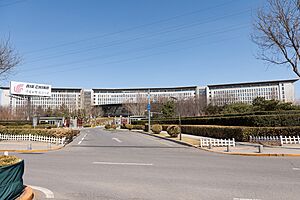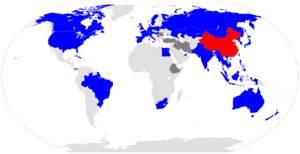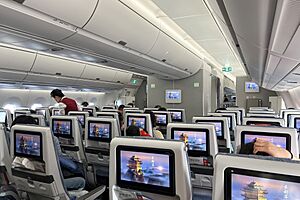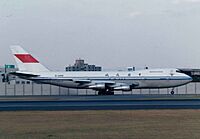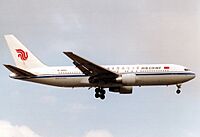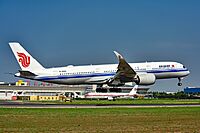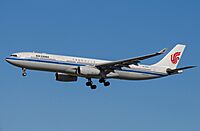Air China facts for kids
 |
|
| Founded | 1 July 1988 |
|---|---|
| Hubs | |
| Secondary hubs |
|
| Focus cities | |
| Frequent-flyer program | PhoenixMiles |
| Alliance | Star Alliance |
| Subsidiaries |
|
| Fleet size | 499 |
| Destinations | 200 |
| Parent company |
|
| Headquarters | Beijing Tianzhu Airport Industrial Zone, Shunyi District, Beijing, China |
| Key people | |
| Employees | 65,000 (2023) |
| Air China Limited | |||||||
|---|---|---|---|---|---|---|---|
| Simplified Chinese | 中国国际航空股份公司 | ||||||
| Traditional Chinese | 中國國際航空股份公司 | ||||||
| Literal meaning | China International Airlines, Company Limited by Shares | ||||||
|
|||||||
| Alternative Chinese name | |||||||
| Simplified Chinese | 中国国际航空公司 | ||||||
| Traditional Chinese | 中國國際航空公司 | ||||||
| Literal meaning | China International Airlines Company | ||||||
|
|||||||
| Air China | |||||||
| Simplified Chinese | 国航 | ||||||
| Traditional Chinese | 國航 | ||||||
| Literal meaning | National Airline | ||||||
|
|||||||
Air China Limited is the flag carrier airline of the People's Republic of China. It is headquartered in Shunyi, Beijing.
Air China's hub airports are based in Beijing and Chengdu. In 2017, the airline carried 102 million domestic and international passengers with an average load factor of 81%. The airline joined Star Alliance in 2007.
Contents
History
Early years
Air China was established and commenced operations on 1 July 1988 as a result of the Chinese government's decision in late 1987 to split the operating divisions of Civil Aviation Administration of China (CAAC Airlines) into six separate airlines: Air China, China Eastern, China Southern, China Northern, China Southwest, and China Northwest. Air China was given chief responsibility for intercontinental flights and took over the CAAC's long haul aircraft (Boeing 747s, 767s, and 707s) and routes.
In January 2001, the former CAAC's ten airlines agreed on a merger plan, according to which Air China was to acquire China Southwest Airlines. Before this acquisition, Air China was the country's fourth largest domestic airline. The merger created a group with assets of 56 billion Yuan (US$8.63 billion), and a fleet of 118 aircraft. In October 2002, Air China consolidated with the China National Aviation Holding and China Southwest Airlines.
On 15 December 2004, Air China was successfully listed on the Hong Kong and London Stock Exchanges. In 2006, Air China signed an agreement to join the Star Alliance. It became a member of the alliance on 12 December 2007 alongside Shanghai Airlines.
In July 2009, Air China acquired $19.3 million of shares from its troubled subsidiary Air Macau, lifting its stake in the carrier from 51% to 80.9%. One month later, Air China spent HK$6.3 billion (US$813 million) to raise its stake in Cathay Pacific from 17.5% to 30%, expanding its presence in Hong Kong.
Development since 2010
In April 2010, Air China completed the increase of shareholdings in Shenzhen Airlines and became the controlling shareholder of Shenzhen Airlines, allowing Air China to further enhance its position in Beijing, Chengdu, and Shanghai as well as achieve a more balanced domestic network.
On 2 December 2010, Air China received Spain's highest tourism industry award, the "Plaque for Tourist Merit." Air China was the first foreign airline to receive the award, which is given to organisations and individuals contributing to the Spanish tourism industry.
On 23 December 2010, Air China became the first Chinese airline to offer combined tickets that include domestic flights and shuttle bus services to nearby cities. The first combined flight-shuttle bus ticket connected Tianjin via shuttle bus with domestic flights passing through Beijing.
Air China began offering free Wi-Fi internet service on board its aircraft on 15 November 2011, making it the first Chinese carrier to offer this service. However the service is not allowed on smartphones, only tablets and laptops.
In 2012, after pressure from PETA, Air China stated that it would no longer transport monkeys to laboratories. PETA welcomed the airline's announcement.
On July 3, 2013, in time for the company's 25th anniversary, Air China successfully tested Wireless LAN in flight. It was the first global satellite Internet flight in Mainland China.
In early 2015 it was announced that the airline had selected the Boeing 737 Next Generation and 737 MAX for its fleet renewal programme of 60 aircraft. The deal, with a value of over $6 billion at current list prices, has yet to be finalised.
Corporate affairs
The entity Air China Limited was registered in 2003, and its shares began trading in Hong Kong and London on December 15, 2004. Originally the airline corporate entity was Air China International, which was founded 2002 Air China International incorporated China Southwest Airlines and the air transportation services of the China National Aviation Corporation, becoming a new entity.
The Air China HQ Building (simplified Chinese: 国航总部大楼; traditional Chinese: 國航總部大樓; pinyin: Guó Háng Zǒngbù Dàlóu), the corporate headquarters, is located in Zone A of the Tianzhu Airport Industrial Zone (simplified Chinese: 天竺空港工业区; traditional Chinese: 天竺空港工業區; pinyin: Tiānzhú Kōng Gǎng Gōngyèqū) in Shunyi District, Beijing. The company registered office is on the ninth floor of the Blue Sky Mansion (simplified Chinese: 蓝天大厦; traditional Chinese: 藍天大廈; pinyin: Lántiān Dàshà), also in Zone A of the Tianzhu Airport Industrial Zone.
The enterprise logo of Air China consists of an artistic Fenghuang pattern, the name of the airline written in calligraphy by former national leader Deng Xiaoping, and "AIR CHINA" in English. The phoenix logo is also the artistic transfiguration of the word "VIP". Air China is a member of the Star Alliance.
Air China is primarily based in its hub of Beijing Capital International Airport (IATA: PEK), where it operates numerous long-range aircraft on routes to North America, Europe, South America, Africa and Australia. Its fleet is made up of an assortment of Boeing and Airbus aircraft, including: Boeing 737s, 777s, 747s, 787s along with Airbus A319s, A320s, A321s and A330s. Air China also operates hubs in Chengdu Shuangliu International Airport, where it primarily flies domestic routes, as well as Shanghai Pudong International Airport, where many international routes served.
Business trends
The key trends for Air China are (as of the financial year ending 31 December):
| 2010 | 2011 | 2012 | 2013 | 2014 | 2015 | 2016 | 2017 | 2018 | 2019 | 2020 | 2021 | 2022 | |
|---|---|---|---|---|---|---|---|---|---|---|---|---|---|
| Total revenue (RMB b) | 80.4 | 95.9 | 99.6 | 98.2 | 105 | 110 | 115 | 121 | 136 | 136 | 69.5 | 74.5 | 52.8 |
| Net profit (RMB b) | 11.9 | 7.5 | 4.8 | 3.2 | 3.8 | 7.0 | 6.8 | 7.2 | 7.3 | 6.4 | −14.4 | −16.6 | −38,6 |
| Number of passengers (m) | 60.0 | 69.6 | 72.4 | 80.8 | 83.0 | 89.8 | 96.6 | 101 | 109 | 115 | 68.6 | 69.0 | 38.6 |
| Passenger load factor (%) | 80.0 | 81.4 | 80.4 | 77.6 | 79.8 | 79.9 | 80.6 | 81.1 | 80.6 | 81.0 | 70.3 | 68.6 | 62.7 |
| Cargo and mail carried (000 tons) | 1,347 | 1,426 | 1,460 | 1,456 | 1,552 | 1,664 | 1,769 | 1,841 | 1,460 | 1,434 | 1,113 | 1,186 | 844 |
| Total aircraft | 393 | 432 | 461 | 497 | 540 | 590 | 623 | 655 | 684 | 699 | 707 | 746 | 762 |
| References |
Ownership structure
| Owner | Number of shares held | Percentage of shares held | |
| 1 | Aviation Corporation of China Ltd. | 6566761847 | 40.53 |
| 2 | Cathay Pacific Airways Limited | 2633725455 | 16.26 |
| 3 | Hong Kong Securities Clearing Company (Nominees) Limited | 1688957345 | 10.43 |
| 4 | Aviation Corporation of China (Group) Limited | 1556334920 | 9.61 |
| 5 | China Securities Finance Corporation Limited | 311302365 | 1.92 |
| 6 | Aviation Fuel Group of China Ltd. | 238524158 | 1.47 |
| 7 | Hong Kong Securities Clearing Company Limited | 156551132 | 0.97 |
| 8 | China State-owned Enterprises Structural Adjustment Fund Co. | 67039106 | 0.41 |
| 9 | China Basic pension fund | 58092370 | 0.36 |
| 10 | China Merchants Anhua Bond Fund | 49638500 | 0.31 |
Destinations
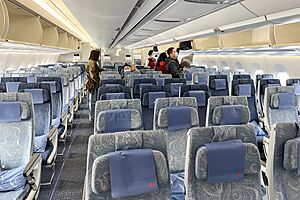
Air China's route network extends throughout Asia to the Middle East, Western Europe, and North America from its hubs at Beijing Capital International Airport and Chengdu Shuangliu International Airport. It also currently reaches a significant number of Asian, Australian and European destinations from Shanghai. Some international routes operate from Chengdu, Chongqing, Dalian, Hangzhou, Kunming and Shenzhen. It is one of the few world airlines that fly to all six habitable continents.
On 10 December 2006, Air China began serving its first South American destination, São Paulo-Guarulhos (via Madrid-Barajas). This was the airline's longest direct flight. The service was initiated with a Boeing 767-300ER, but due to increased demand, the service has been upgraded to an Airbus A330-200, and later a Boeing 787-9.
Regular flights between mainland China and Taiwan started in July 2009. Due to the political status of Taiwan, all Air China airframes that operate flights to and from Taiwan are required to cover the flag of the People's Republic of China on the fuselage.
Air China introduced its new Airbus A330-300 to long-haul operations beginning with services to Düsseldorf, Germany in summer 2011. These aircraft provided the same two-class cabin standard as the Airbus A330-200 except that the economy cabin had no seat-back entertainment system installed (with the exception of the first two economy rows which also had increased legroom). Düsseldorf is now the third German destination on the Air China network. The airline launched a new Beijing-Milan-Malpensa service on 15 June 2011, complementing the airline's existing service to Milan from Shanghai.
Deliveries of the carrier's 19 new Boeing 777-300ERs commenced in mid-2011, with the aircraft forming the new "backbone of its future longhaul operations." The new Boeing 777-300ERs replaced the Boeing 747-400s on routes to U.S. destinations such as Los Angeles, New York, and San Francisco, but was expected to first enter service on flights to Paris from March 2012. The Boeing 777-300ER began to replace most 747 service once sufficient numbers entered the fleet. Air China expanded its operations in India with a Beijing-Mumbai route begun in September 2011, while the existing Delhi route was upgraded to the A330. The airline also launched service to Mumbai from Chengdu on 2 May 2012. The airline began using the Boeing 777-300ER on one of its two daily Beijing-Los Angeles flights on 1 February 2012. In the late-2012's to early 2013's, the airline replaced the Boeing 747-400s servicing the New York and San Francisco routes with the Boeing 777-300ER. With the addition of the Boeing 777-300ERs on the US routes, Air China increased frequency on the Beijing-New York route, changing the flights from 7 to 11 flights a week by adding two new flights to the route (CA989/990). On 21 January 2014, the airline launched its service to Hawaii with flights from Beijing to Honolulu, the first nonstop flights between the two cities. The airline also increased the frequency of service on the Beijing-Houston Intercontinental route from four times weekly to daily service from 30 March 2014. Beginning 10 June 2014, Air China introduced new nonstop service from Beijing to Washington-Dulles, operated by a Boeing 777-300ER. As of September 29 2015, Air China also introduced a 3 times weekly flight to Montréal–Pierre Elliott Trudeau International Airport in a codeshare with Air Canada. The Montreal flight was extended to Havana from 27 December 2015.
Air China started its direct flights to Johannesburg, South Africa from 29 October 2015.
Air China codeshares with the following airlines:
- Air Canada (Joint Venture Partner)
- Air Dolomiti
- Air India
- Air Macau
- Air New Zealand
- Air Serbia
- All Nippon Airways
- Asiana Airlines
- Austrian Airlines
- Avianca
- Cathay Pacific
- China Express Airlines
- El Al
- Ethiopian Airlines
- EVA Air
- Finnair
- Garuda Indonesia
- Hawaiian Airlines
- Juneyao Air
- Kunming Airlines
- LATAM Brasil
- LATAM Chile
- LOT Polish Airlines
- Lufthansa
- Scandinavian Airlines
- Shandong Airlines
- Shenzhen Airlines
- Singapore Airlines
- South African Airways
- Swiss International Air Lines
- TAP Air Portugal
- Tibet Airlines
- Turkish Airlines
- Uni Air
- United Airlines
- Virgin Atlantic
- WestJet
Interline agreements
Air China has Interline agreements with the following airlines:
Fleet
Current fleet
As of December 2023[update], Air China operates the following aircraft:
| Aircraft | In service | Orders | Passengers | Notes | ||||
|---|---|---|---|---|---|---|---|---|
| F | B | E+ | E | Total | ||||
| Airbus A319-100 | 30 | — | — | 8 | — | 120 | 128 | |
| Airbus A319neo | — | 13 | TBA | |||||
| Airbus A320-200 | 38 | — | — | 8 | — | 150 | 158 | |
| Airbus A320neo | 53 | 8 | — | 8 | — | 150 | 158 | |
| Airbus A321-200 | 61 | — | — | 16 | — | 161 | 177 | |
| 12 | 173 | 185 | ||||||
| Airbus A321neo | 30 | 45 | — | 12 | — | 182 | 194 | |
| Airbus A330-200 | 21 | — | — | 30 | — | 207 | 237 | |
| 18 | 247 | 265 | ||||||
| 12 | 271 | 283 | ||||||
| Airbus A330-300 | 28 | — | — | 30 | 16 | 255 | 301 | |
| 36 | 20 | 311 | ||||||
| Airbus A350-900 | 30 | — | — | 32 | 24 | 256 | 312 | |
| Boeing 737-700 | 18 | — | — | 8 | — | 120 | 128 | B-3999 used for VIP transport. |
| Boeing 737-800 | 88 | — | — | 8 | — | 159 | 167 | |
| 168 | 176 | |||||||
| 12 | 147 | 159 | ||||||
| Boeing 737 MAX 8 | 20 | 18 | — | 8 | — | 168 | 176 | |
| Boeing 747-400 | 3 | — | 10 | 42 | — | 292 | 344 | To be retired by 2025 |
| Boeing 747-8I | 7 | — | 12 | 54 | 66 | 233 | 365 | B-2479 used for VIP transport. |
| Boeing 777-300ER | 28 | — | 8 | 42 | — | 261 | 311 | |
| — | 36 | 356 | 392 | |||||
| Boeing 787-9 | 14 | — | — | 30 | 34 | 229 | 293 | |
| Comac ARJ21-700 | 25 | 10 | — | — | — | 90 | 90 | Deliveries until 2024. |
| Comac C919 | — | 105 | TBA | Deliveries until 2031 | ||||
| Air China Business Jets fleet | ||||||||
| Boeing BBJ1 | 1 | — | VIP | Operated by Beijing Airlines. | ||||
| Boeing BBJ2 | 3 | — | VIP | |||||
| Dassault Falcon 7X | 1 | — | VIP | |||||
| Total | 499 | 199 | ||||||
Former fleet
| Aircraft | Total | Introduced | Retired | Notes |
|---|---|---|---|---|
| Airbus A340-300 | 6 | 1997 | 2014 | |
| Boeing 707-320 | 6 | 1988 | 1993 | |
| Boeing 737-200 | 4 | 1988 | 1995 | Disposed to Air Great Wall. |
| Boeing 737-300 | 44 | 1988 | 2014 | |
| Boeing 737-600 | 6 | 2003 | 2009 | |
| Boeing 747-200M | 3 | 1988 | 2000 | Converted into freighters and transferred to Air China Cargo. |
| Boeing 747-400M | 4 | 1989 | 2013 | |
| 3 | Converted into freighters and transferred to Air China Cargo. | |||
| Boeing 747SP | 4 | 1988 | 2000 | |
| Boeing 757-200 | 9 | 2003 | 2010 | Converted into freighters and disposed to SF Airlines. |
| 4 | Converted into freighters and transferred to Air China Cargo. | |||
| Boeing 767-200ER | 5 | 1988 | 2009 | |
| 1 | 2002 | Crashed as flight CA129. | ||
| Boeing 767-300 | 4 | 1993 | 2012 | |
| Boeing 767-300ER | 5 | 2003 | 2012 | |
| Boeing 777-200 | 10 | 1998 | 2018 | Three aircraft are stored. |
| BAe 146-100 | 4 | 1988 | 2008 | |
| Gulfstream IV | 1 | Unknown | Unknown | Used for VIP flights. |
| Hawker Siddeley Trident | 3 | 1988 | 1991 | |
| Learjet 45 | 1 | 2004 | 2007 | Used for VIP flights. |
| Lockheed L-100 Hercules | Unknown | Unknown | Unknown | |
| Xian Y-7 | 3 | 1988 | 1996 |
Air China Cargo
Air China Cargo, is a subsidiary of Air China, that focuses on freight delivery and does not transport passengers. It operates routes across Asia, Europe and North America with its fleet of Boeing 747-400Fs, Boeing 757-200PCF and Boeing 777F.
Accidents and incidents
- On 15 April 2002, Air China Flight 129, a Boeing 767-200ER from Beijing to Busan, South Korea, crashed into a hill while trying to land at Gimhae International Airport during inclement weather, killing 129 of the 166 people on board. This is Air China's only fatal accident to date.
- On 15 March 2003, Air China Flight 112, operated by a Boeing 737-36N carried a 72 year old man infected with SARS. The infection later transmitted to 20 other passengers during the flight, causing 5 of them to later die from SARS. It was the largest in-flight super-spread transmission of SARS during the 2003 SARS epidemic.
- On 27 August 2019, Air China Flight 183, an Airbus A330-343X from Beijing to Tokyo, Japan, was damaged beyond repair due to a cargo fire while on the ground at Beijing just shortly before departure. No one was injured.
- On 10 September 2023, Air China Flight 403, operated by an Airbus A320neo (B-305J) from Chengdu Tianfu International Airport to Singapore Changi Airport, had a fire in its left engine right before landing. The plane made an emergency landing in Singapore at 4.15pm with all passengers and crew members safely evacuated. Nine passengers sustained minor injuries related to smoke inhalation and abrasions during evacuation.
See also
 In Spanish: Air China para niños
In Spanish: Air China para niños
- Aviation industry in the People's Republic of China
- List of airlines of the People's Republic of China
- List of airports in the People's Republic of China
- List of companies of the People's Republic of China
- Transportation in the People's Republic of China



